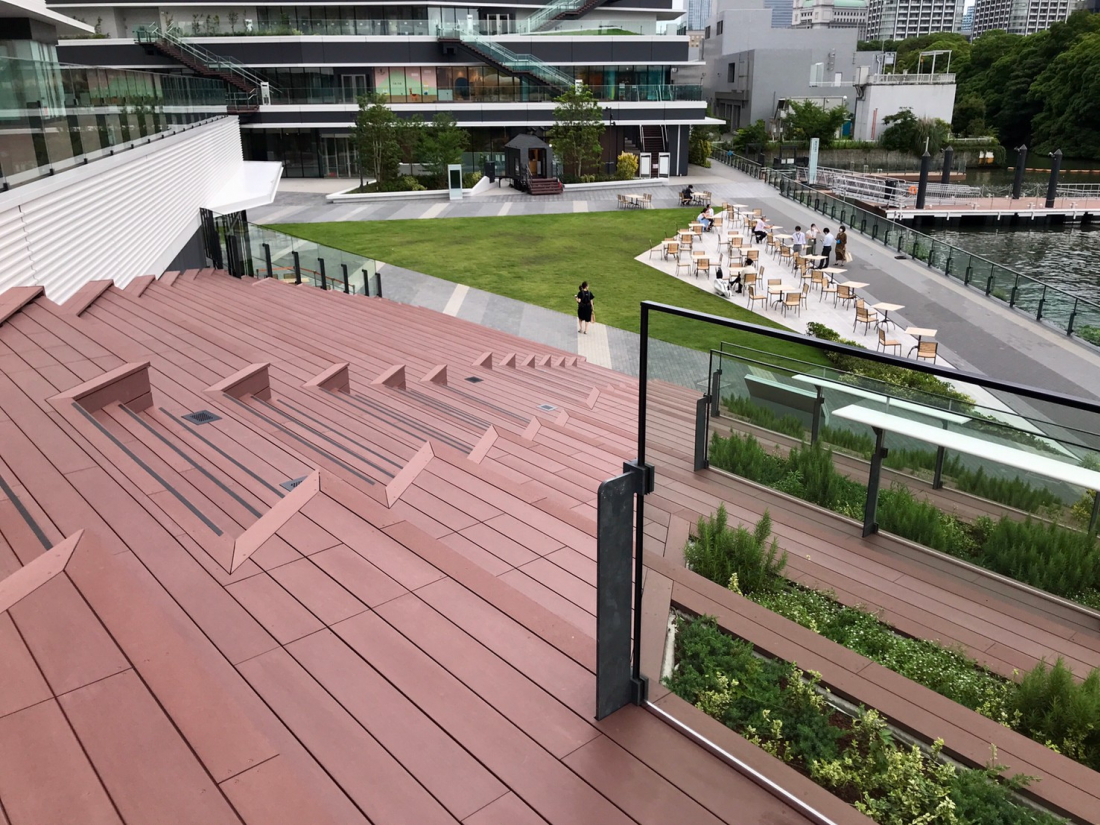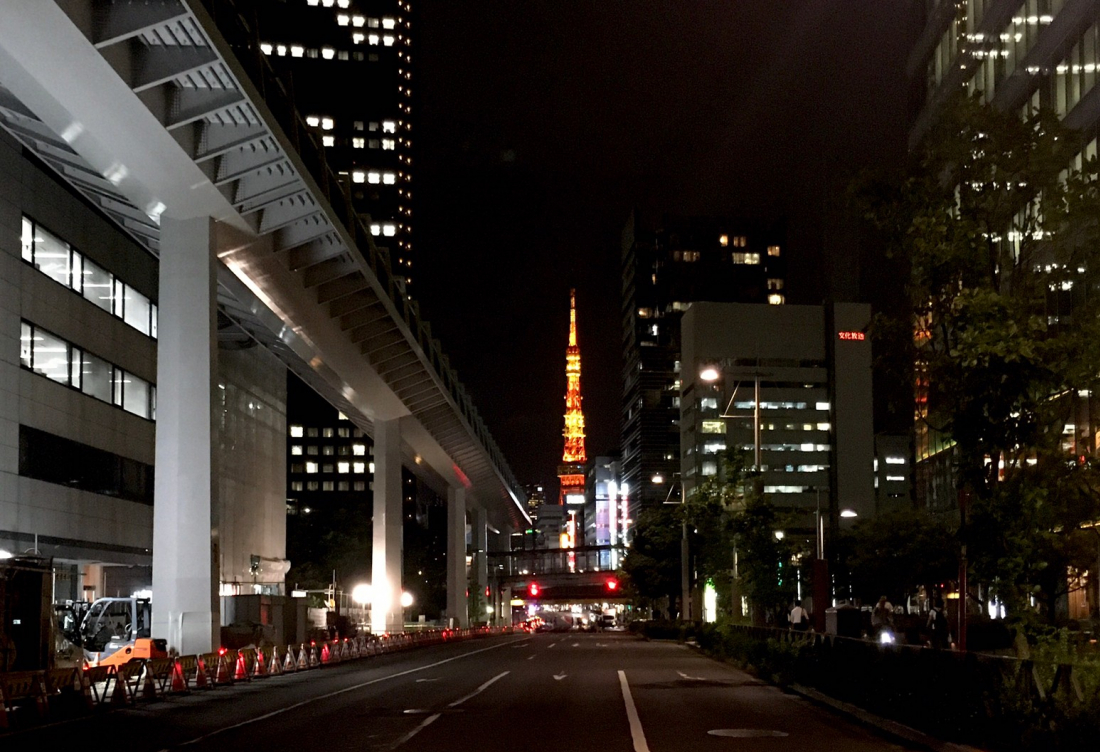CONTENTS
The new Waters Takeshiba facility in southern Tokyo is a breezy spot to grab a bite to eat.
Waters Takeshiba (ウォーターズ竹芝)
Image Source: Official Website
Waters Takeshiba, a brand new shopping, eating, and leisure facility off of Tokyo Bay, opened this June as part of a wave of new spots delayed by the COVID-19 outbreak. So, after our recent trips to With Harajuku and Tokyo Mizumachi, the Japankuru team decided we had to head towards the water to take a look at what makes this compound unique and different from the others!
As a new stop on the Sumida River cruise lines, clearly constructed to be a place where visitors can just hang out and enjoy a breezy afternoon on the water, even with quite a few of the businesses in the compound still unopened, we could tell it had its own appeal.
There are three main facilities encompassed by Waters TakeshibaーAtre Takeshiba, a small shopping mall mostly full of food shops of various kinds, Hotel Mesm Tokyo, a new high-end hotel above the mall, and a theater for the Shiki Theatre Company, who perform mainly Broadway musicals. With plans to just drop by and take a look around (and many spaces still not yet open), we mostly stuck to the outdoor area and the mall.
A wide-open lawn, plenty of freely available outdoor seating, and trendy eateriesーafter an afternoon at Waters Takeshiba, the Japankuru team decided that while it might not be a must-see destination in and of itself (unless you're there for a show), it's definitely worth adding to your plans if you're in the area.
Waters Takeshiba is easily accessible from either JR Hamamatsu Station or the Yurikamome Takeshiba Station, meaning it might make a nice lunch or cafe stop on an itinerary that includes either Tokyo Tower, or any of nearby Odaiba's attractions (like teamLab). But perhaps even more intriguing is the fact that it's a new stop on a Sumida River cruise/water bus line. If you've ever noticed the boats on the river while walking in Asakusa or crossing the water to see Tokyo Skytree, well, if you board one you'll find that it follows the river all the way south towards Tokyo Bay. The "water buses" are fairly easy to ride, they're a fun way to see the city from a whole new perspective, and the boarding dock is actually quite near the Sumida River Walk. If you're up for a day of shopping and leisure, combining Asakusa, Tokyo Skytree, Tokyo Mizumachi, and Waters Takeshiba would all be pretty convenient. Just make sure you check the water bus schedule beforehandーit doesn't operate all day every day.
All of the outdoor seating at Waters Takeshiba looks out onto a lovely view of the area where Tokyo's rivers join and meet Tokyo Bay. We could definitely imagine doing a little sunbathing on the lawn or grabbing a coffee and watching the little water bus boats come and go, floating over the green water. Additionally, right across from the facility is Hama-rikyu Gardens (once a 17th-century villa for nobles, and now a beautiful sculpted green space open to the public), making the view green and refreshing.
We're interested to see what happens with this area, named the "Tideland" and intended as a natural swimming and recreation area connected to and protecting the local ecosystem. (Eagle-eyed readers might even be able to spot some surprisingly large cormorants in the background of the low tide picture above.) When we visited it was closed off to visitors, so perhaps we'll have to come back again another time!
Indoor Shopping & Eating
Atre is a shopping mall chain, and while most locations contain dozens of shops selling fashion, home goods, books, etc., Atre Takeshiba is a little more concentrated on one theme: food. Inside the stylishly decorated building, there are currently two floors open, with a third floor that's one big "coming soon." Shopping is limited to a Natural Lawson (a convenience store with a particularly large selection of organic and imported goods), and a Bio c' Bon (a "natural" grocery store). And while the restaurant selection isn't extensive, it does offer a reasonable variety: casual Japanese fare at Tsumugi, German meat and beer at Brauertafel, coffee at Coffee-Kan, and trendy burgers at The 3rd Burger. (August will bring the opening of the more high-end Sud Restaurant/Terakoya.)
The interior design is all very trendy, and definitely a change from the fairly minimalist look you'll see in most Japanese malls and department stores!
We were particularly intrigued by the selection at Bio c' Bon, which sold organic fresh produce, bulk nuts and organic chocolate, imported pasta, cereal, bread, beer, cookies, etc. etc., and even a selection of wines. While some of us had seen this particular grocery store brand elsewhere, this location is fairly large, allowing for a wide variety of products.
Obviously a bit less popular during the COVID-19 pandemic, we were definitely drawn to the small counter right inside the grocery store itself! In less anxious times, we could definitely imagine skipping the next-door coffee shop and grabbing a glass of wine with a snack instead.
When our stomachs started to rumble, though, we instead opted for burgers. When we first arrived at Waters Takeshiba, the friendly waterbus dock worker told us that The 3rd Burger is a favorite among young local office workers.
A look at the interior design and the menu definitely gave us some idea of why it was popularーall very trendy, with toppings like wasabi and avocado, and most burgers coming in grilled chicken options as well. While not as cheap as something like Mcdonald's, prices were certainly reasonable as well (and quality was clearly better), making it a good lunch spot!
Above is the wasabi avocado burger, which was topped with lettuce, tomato, avocado, and wasabi sauce. For those afraid of the heat, the wasabi was more flavorful and less nose-burning, so it's not an adventurous choice you'd end up regretting.
Hanging Out Outside
While we certainly enjoyed the burgers, we spent most of our time at Waters Takeshiba just wandering around outside and hanging out enjoying the weather. Aside from the seating right on the water, we feel sure this massive staircase will definitely become a popular hangout on sunny Tokyo weekends.
Growing in boxes set between seating platforms, the pretty plants add a refreshing swath of green to the area, and include quite a few aromatics. On a warm early summer afternoon, we wanted to just sit and breathe in the rosemary for hours.
We definitely recommend stopping by for an afternoon snack, grabbing something from the convenience store, and just relaxing for a while. If the crazy hustle and bustle of neighborhoods like Shinjuku or Shibuya is starting to get to you, take a little break in this more relaxed area of Tokyo.
The area is possibly even more lovely at night, when the stairs light up and you can even see Tokyo Skytree glowing as part of the skyline across the water.
(Remember how close it is to Tokyo Tower? If you head back for the night via the JR station, don't forget to check out the Eiffel-esque tower glowing in the night sky!)
Have you been to Waters Takeshiba yet? Been to any other new facilities in Tokyo recently that you're dying to tell someone about? We'd love to hear from you at the Japankuru twitter, instagram, and facebook!
Details
NAME:Waters Takeshiba (ウォーターズ竹芝)
ACCESS:Takeshiba Station, Hamamatsu Station
Between collaboration items and special-edition limited-time-only goods, Japan has some pretty interesting products, and if you're anything like me... well, you can't help but be interested!
COMMENT
FEATURED MEDIA
VIEW MORE 
A New Tokyo Animal Destination: Relax & Learn About the World’s Animals in Japan
#pr #japankuru #anitouch #anitouchtokyodome #capybara #capybaracafe #animalcafe #tokyotrip #japantrip #카피바라 #애니터치 #아이와가볼만한곳 #도쿄여행 #가족여행 #東京旅遊 #東京親子景點 #日本動物互動體驗 #水豚泡澡 #東京巨蛋城 #เที่ยวญี่ปุ่น2025 #ที่เที่ยวครอบครัว #สวนสัตว์ในร่ม #TokyoDomeCity #anitouchtokyodome

Shohei Ohtani Collab Developed Products & Other Japanese Drugstore Recommendations From Kowa
#pr #japankuru
#kowa #syncronkowa #japanshopping #preworkout #postworkout #tokyoshopping #japantrip #일본쇼핑 #일본이온음료 #오타니 #오타니쇼헤이 #코와 #興和 #日本必買 #日本旅遊 #運動補充能量 #運動飲品 #ช้อปปิ้งญี่ปุ่น #เครื่องดื่มออกกำลังกาย #นักกีฬา #ผลิตภัณฑ์ญี่ปุ่น #อาหารเสริมญี่ปุ่น

도쿄 근교 당일치기 여행 추천! 작은 에도라 불리는 ‘가와고에’
세이부 ‘가와고에 패스(디지털)’ 하나면 편리하게 이동 + 가성비까지 완벽하게! 필름카메라 감성 가득한 레트로 거리 길거리 먹방부터 귀여움 끝판왕 핫플&포토 스폿까지 총집합!
Looking for day trips from Tokyo? Try Kawagoe, AKA Little Edo!
Use the SEIBU KAWAGOE PASS (Digital) for easy, affordable transportation!
Check out the historic streets of Kawagoe for some great street food and plenty of picturesque retro photo ops.
#pr #japankuru #도쿄근교여행 #가와고에 #가와고에패스 #세이부패스 #기모노체험 #가와고에여행 #도쿄여행코스 #도쿄근교당일치기 #세이부가와고에패스
#tokyotrip #kawagoe #tokyodaytrip #seibukawagoepass #kimono #japantrip

Hirakata Park, Osaka: Enjoy the Classic Japanese Theme Park Experience!
#pr #japankuru #hirakatapark #amusementpark #japantrip #osakatrip #familytrip #rollercoaster #retrôvibes #枚方公園 #大阪旅遊 #關西私房景點 #日本親子旅行 #日本遊樂園 #木造雲霄飛車 #히라카타파크 #สวนสนุกฮิราคาตะพาร์ค

🍵Love Matcha? Upgrade Your Matcha Experience With Tsujiri!
・160년 전통 일본 말차 브랜드 츠지리에서 말차 덕후들이 픽한 인기템만 골라봤어요
・抹茶控的天堂!甜點、餅乾、飲品一次滿足,連伴手禮都幫你列好清單了
・ส่องมัทฉะสุดฮิต พร้อมพาเที่ยวร้านดังในอุจิ เกียวโต
#pr #japankuru #matcha #matchalover #uji #kyoto #japantrip #ujimatcha #matchalatte #matchasweets #tsujiri #말차 #말차덕후 #츠지리 #교토여행 #말차라떼 #辻利抹茶 #抹茶控 #日本抹茶 #宇治 #宇治抹茶 #日本伴手禮 #抹茶拿鐵 #抹茶甜點 #มัทฉะ #ของฝากญี่ปุ่น #ชาเขียวญี่ปุ่น #ซึจิริ #เกียวโต

・What Is Nenaito? And How Does This Sleep Care Supplement Work?
・你的睡眠保健品——認識「睡眠茶氨酸錠」
・수면 케어 서플리먼트 ‘네나이토’란?
・ผลิตภัณฑ์เสริมอาหารดูแลการนอน “Nenaito(ネナイト)” คืออะไร?
#pr #japankuru #sleepcare #japanshopping #nenaito #sleepsupplement #asahi #睡眠茶氨酸錠 #睡眠保健 #朝日 #l茶胺酸 #日本藥妝 #日本必買 #일본쇼핑 #수면 #건강하자 #네나이토 #일본영양제 #อาหารเสริมญี่ปุ่น #ช้อปปิ้งญี่ปุ่น #ร้านขายยาญี่ปุ่น #ดูแลตัวเองก่อนนอน #อาซาฮิ

Japanese Drugstore Must-Buys! Essential Items from Hisamitsu® Pharmaceutical
#PR #japankuru #hisamitsu #salonpas #feitas #hisamitsupharmaceutical #japanshopping #tokyoshopping #traveltips #japanhaul #japantrip #japantravel

Whether you grew up with Dragon Ball or you just fell in love with Dragon Ball DAIMA, you'll like the newest JINS collab. Shop this limited-edition Dragon Ball accessory collection to find some of the best Dragon Ball merchandise in Japan!
>> Find out more at Japankuru.com! (link in bio)
#japankuru #dragonball #dragonballdaima #animecollab #japanshopping #jins #japaneseglasses #japantravel #animemerch #pr

This month, Japankuru teamed up with @official_korekoko to invite three influencers (originally from Thailand, China, and Taiwan) on a trip to Yokohama. Check out the article (in Chinese) on Japankuru.com for all of their travel tips and photography hints - and look forward to more cool collaborations coming soon!
【橫濱夜散策 x 教你怎麼拍出網美照 📸✨】
每次來日本玩,是不是都會先找旅日網紅的推薦清單?
這次,我們邀請擁有日本豐富旅遊經驗的🇹🇭泰國、🇨🇳中國、🇹🇼台灣網紅,帶你走進夜晚的橫濱!從玩樂路線到拍照技巧,教你怎麼拍出最美的夜景照。那些熟悉的景點,換個視角說不定會有新發現~快跟他們一起出發吧!
#japankuru #橫濱紅磚倉庫 #汽車道 #中華街 #yokohama #japankuru #橫濱紅磚倉庫 #汽車道 #中華街 #yokohama #yokohamaredbrickwarehouse #yokohamachinatown

If you’re a fan of Vivienne Westwood's Japanese designs, and you’re looking forward to shopping in Harajuku this summer, we’ve got important news for you. Vivienne Westwood RED LABEL Laforet Harajuku is now closed for renovations - but the grand reopening is scheduled for July!
>> Find out more at Japankuru.com! (link in bio)
#japankuru #viviennewestwood #harajuku #omotesando #viviennewestwoodredlabel #viviennewestwoodjapan #비비안웨스트우드 #오모테산도 #하라주쿠 #日本購物 #薇薇安魏斯伍德 #日本時尚 #原宿 #表參道 #japantrip #japanshopping #pr

Ready to see TeamLab in Kyoto!? At TeamLab Biovortex Kyoto, the collective is taking their acclaimed immersive art and bringing it to Japan's ancient capital. We can't wait to see it for ourselves this autumn!
>> Find out more at Japankuru.com! (link in bio)
#japankuru #teamlab #teamlabbiovortex #kyoto #kyototrip #japantravel #artnews
Photos courtesy of teamLab, Exhibition view of teamLab Biovortex Kyoto, 2025, Kyoto ® teamLab, courtesy Pace Gallery

Japanese Makeup Shopping • A Trip to Kamakura & Enoshima With Canmake’s Cool-Toned Summer Makeup
#pr #canmake #enoshima #enoden #에노시마 #캔메이크 #japanesemakeup #japanesecosmetics

⚔️The Robot Restaurant is gone, but the Samurai Restaurant is here to take its place. Check it out, and don't forget your coupon!
🍣신주쿠의 명소 로봇 레스토랑이 사무라이 레스토랑으로 부활! 절찬 쿠폰 발급중
💃18歲以上才能入場的歌舞秀,和你想的不一樣!拿好優惠券去看看~
#tokyo #shinjuku #samurairestaurant #robotrestaurant #tokyotrip #도쿄여행 #신주쿠 #사무라이레스토랑 #이색체험 #할인이벤트 #歌舞伎町 #東京景點 #武士餐廳 #日本表演 #日本文化體驗 #japankuru #japantrip #japantravel #japanlovers #japan_of_insta

Japanese appliance & electronics shopping with our KOJIMA x BicCamera coupon!
用JAPANKURU的KOJIMA x BicCamera優惠券買這些正好❤️
코지마 x 빅 카메라 쿠폰으로 일본 가전 제품 쇼핑하기
#pr #japankuru #japanshopping #kojima #biccamera #japaneseskincare #yaman #dji #osmopocket3 #skincaredevice #日本購物 #美容儀 #相機 #雅萌 #日本家電 #일본여행 #면세 #여행꿀팁 #일본쇼핑리스트 #쿠폰 #일본쇼핑 #일본브랜드 #할인 #코지마 #빅카메라 #japankurucoupon
































































